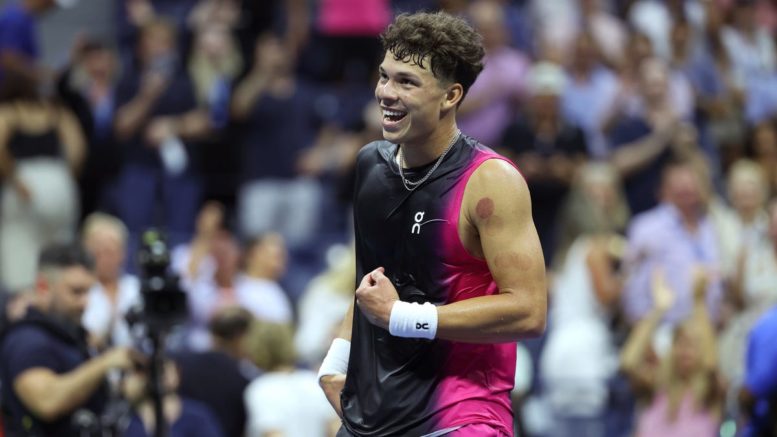There’s been a lament, until recently, that on the men’s side American tennis just had a ceiling. And that ceiling wasn’t anywhere close to winning a Grand Slam. Which is a little unfair to Andy Roddick, who without the existence of Roger Federer would have been a multi-Wimbledon champion and probably added another US Open or Australian Open to it too.
But that was the thing about Roddick, and just about every other Yank to come along since. You knew there was a limit. Roddick’s game never developed much beyond a big serve and a big forehand, and compared to the diversity and dynamism of others who were challenging you knew it just didn’t measure up. You saw other players’ games and Roddick’s and it was easy to say to yourself, “Yeah, nah.”
John Isner? One trick pony. Sam Querrey didn’t have quite enough of everything. And on and on it went. They may provide a thrill or two, but everyone knew when the business really got done they didn’t have the stack to measure up.
While men’s American tennis is providing more options these days and more hope, there’s still a feeling that that ceiling is still in place. Watch Taylor Fritz putter around the court, no matter what his serve and groundstrokes do, and you can see how the top of the top will expose him. Frances Tiafoe has more of the all-court game, and way more of the bravado, and has altered his game from what used to be red-line-is-a-good-time ways to include a surprising amount of touch and variety. There’s still time for Foe, but there’s still a feeling that no matter what weapons he develops or invents, he won’t ever have the biggest artillery in a draw.
But the man he lost to on Tuesday night, Ben Shelton, suddenly it feels like the US has a tennis player that can’t be contained, that’s capable of anything, that is unstable in the best way. That he will have things that you can’t account for.
Oh sure, the BIG WEAPONS are easily identified. The serve that can nuzzle up to 150 MPH. The forehand that sounds like a crack of a whip. There’s the athleticism too, that he can motor all over the court and produce something when he gets there.
But in defeating Tiafoe to reach his first semifinal, it wasn’t just an exhibition of going for broke and rolling sevens all night. Shelton’s return game is supposedly his weakness, and yet he broke Tiafoe seven times. He varied those returns too, sometimes blasting them right back at Tiafoe, sometimes chipping, sometimes looping, never making it clear what was next. It was watching him learn on the fly.
He came to the net and won a majority of those points. He stayed in long rallies which is where Tiafoe was supposed to beat him after dragging him into the deep water. Eventually, the latter was out of answers.
And oh, right, there’s the balls too. Because when you hit two consecutive double faults to give your opponent a set point to go up 2-1, you better have a set to come up with this:
That’s rude, that’s not on script, that’s something you can’t quantify or contain. It’s one thing to show all the swagger when things are going well. It’s another to do so when everything is going against you. Indicates there’s something within that can’t break.
Oh don’t worry, Shelton has a long way to go. Even though he made the quarters in Melbourne, he has spent the rest of the season not being able to string together two wins. His ranking is still in the 40s. He’s only 20. There may be a swift thwack from reality in waiting from Novak Djokovic in the semifinal on Friday.
Worry about that then. Shelton has shown enough raw material, with a heavy pinch of that thing you can’t put a label on, to make anyone think that he can eventually have the game that has it all. That doesn’t have a ceiling. That’s where the big stuff is and won.
It’s starting to feel like Coco Gauff’s time
On the women’s side, it’s definitely starting to feel like Coco Gauff’s time. Coming into the US Open she had just won her first WTA 1000 tournament in Cincinnati. She tore apart Jelena Ostapenko on Tuesday, who had just dispatched world No. 1 (for now) Iga Swiatek in the previous round.
Gauff hasn’t been able to escape expectations and the spotlight, even though she was at a point in her career when she was rarely ready for it. When you’re 15 and American and beat Venus Williams in the first round at Wimbledon, as Gauff did, people are going to remember your name and ESPN is going to put you on TV. And all of that doesn’t necessarily have the patience for a player that young to build her game to be ready for a moment like this.
It’s come together for Gauff now, who has a power to her game that few of her opponents can match to go along with her top-tier athleticism. There’s still Aryna Sabalenka, and defending Wimbledon champ Marketa Vondrousova, along with Madison Keys who has been here before to get through. But Gauff has never looked more likely to do so than now.
Follow Sam on Twitter @Felsgate and on Bluesky @Felsgate.bsky.social
Original source here
#Ben #Shelton #feels #limitless





